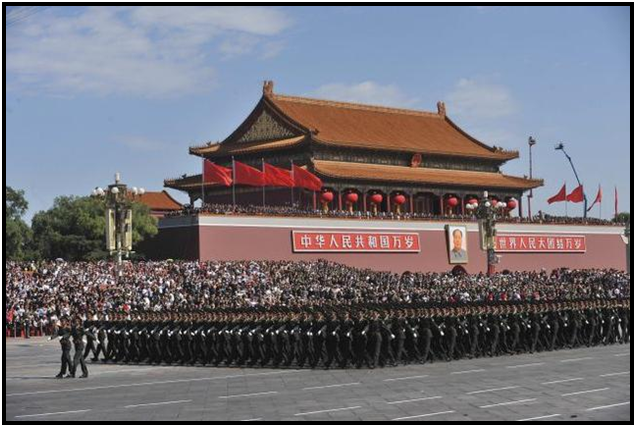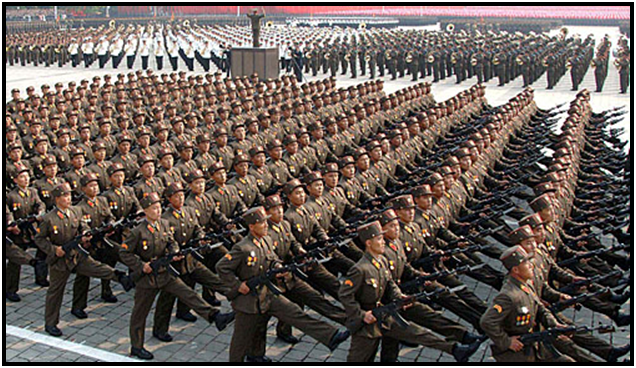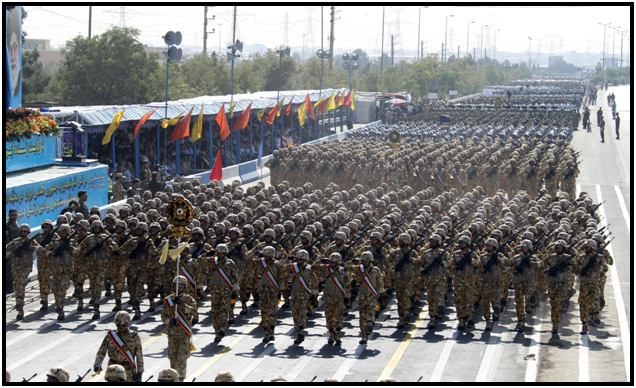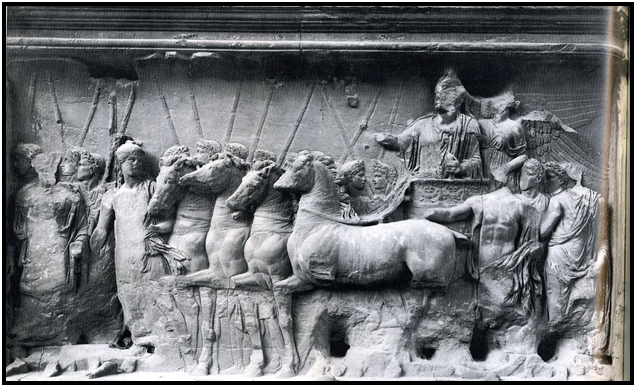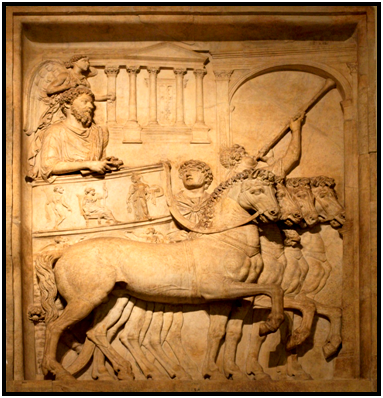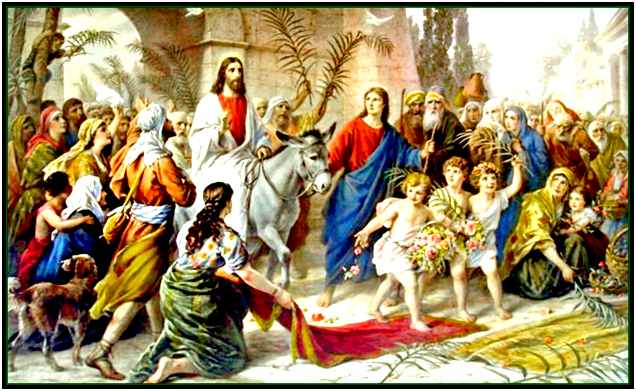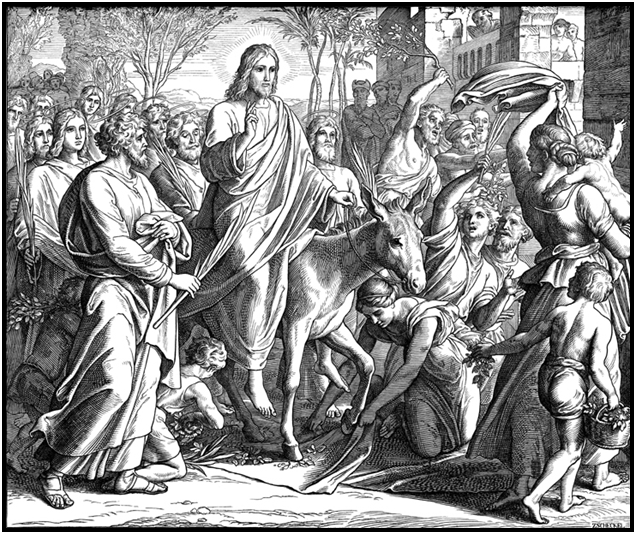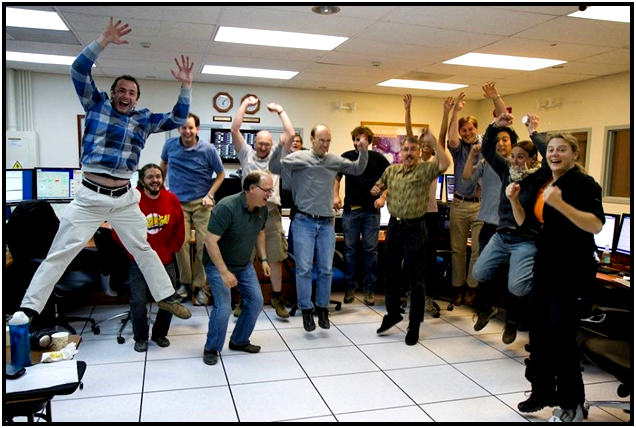REVISING EXPECTATIONS
A Sermon by the Rev. Dr. Arthur M. Suggs
Preached on Palm Sunday, April 13, 2014
Instant Karma Will Get You Back
The sermon is a little unusual this morning in that it is both for the children and also for the adults, so wish me luck. I was ill last week, and one of the consequences of being under the weather is that I spent a bit too much time surfing the net. I came across a website that was tears-in-your-eyes funny, having to do with what’s called instant Karma.
Do you know what Karma is? It’s a notion that, if you send out something bad, bad comes back to you. So if you put out a bad word, a bad thought, or especially a bad action, bad sort of finds its way back to you. Not always instantly, but like oatmeal, sometimes there’s instant Karma. Other times it takes a while, but it always comes back. The same thing happens with good. Good words, good comes back to you. Good actions, good comes back to you.
So this website was about instant Karma. The story involves an unsuspecting girl standing in a gym class facing the bleachers, which had been pushed back against the wall to make more space on the floor. She’s minding her own business when another kid, a little bigger than she, begins sneaking up behind her holding one of those pink balls that you find in gym classes. He’s getting ready to hurl the ball at the back of her head. A perfect target, facing the other way and completely unaware.
Now is that a nice thing to do? No. Okay, it’s funny. I’ve done it before, I admit. But it’s still not nice to sneak up behind somebody and throw a ball at the back of their head.
Nevertheless, that’s what he’s fixing to do. But just at the very moment he cocks his arm to fire the missile, his target suddenly stoops down to pick up something off the floor. He lets go with a fastball. It just grazed the top of her hair so she noticed it but was not hit by it.
Instead, the ball hit the bleacher hard, rebounded straight from a board on the bleacher, whizzed right over the girl’s head back to the thrower, and smacked him right in the face.
That’s instant Karma.
An Angry Driver Stars on Camera
Another story on this website was also reported on the news about a woman who was driving in Florida. She’s minding her own business driving along, when she sees behind her a pickup truck whose driver is really mad trying to get past her. Flashing his lights, honking his horn, trying to get around. She’s going the speed limit so she’s not really motivated to go a lot faster for this guy. It’s like, deal with it. However, he’s evidently so angry that she whips out her cell phone, which has a camera, and within moments she is videoing him.
With her left hand, she aims the camera over her right shoulder through the rear window while steering with her right hand, looking in the rearview mirror, watching the truck, staying on the road, and driving normally. All the time she’s videoing this guy.
Well, the next thing you know, her single lane widens into two lanes. The woman stays in the left lane. The pickup truck swoops into the right lane before she can move over, and instead of just passing, he pulls up beside her and makes an obscene gesture. It was a negative thing, a very mean gesture. By this time, though, she’s filming the guy through her passenger window and catches it all on camera.
Suddenly, in a steaming fit of self-righteous rage, the guy tromps on the gas pedal, zooms leftward in front of her, and cuts so hard that he loses control and goes spinning down onto the median between the roads.
The woman slows down and continues videoing as the guy goes off the road. She got his license number. She got his face when his hand wasn’t in the way. She filmed the whole thing and sent it to the police.
That’s instant Karma.
Two Birds Hang Up and Crack Up
This one made me remember a case of instant Karma that I saw myself. I was walking toward Bon-Ton’s in the mall, about ten feet behind a pair of girls. They were together on one phone call, leaning close to each other so as to share the phone while talking to a third person on the other end and paying no attention to their surroundings. We’re getting close to Bon-Ton’s entrance.
It was a very energetic conversation. I couldn’t hear the words, but the two were extremely upset about something and were intent upon their conversation. Finally, as they neared the door, the girl holding the phone hangs up abruptly, turns to her friend, and explodes with some very profane words.
She had called the party on the other end a string of very bad names and was heatedly recounting them to her companion at the very moment the two of them strode obliviously into the plate glass doors of Bon-Ton’s.
That’s instant Karma.
Karma in a Four-in-Hand or on a Donkey?
I have just given you three cases of negative Karma. It is equally positive, though, and I want to give you an extraordinary example of putting good Karma out into the world and good coming back.
First let me set the scene for you. The first three pictures show modern armies marching. For comparison, the fourth image represents the ancient army of the Roman legions.
The Chinese Army Marching
The North Korean Army Marching
The United States Army Marching in Iraq
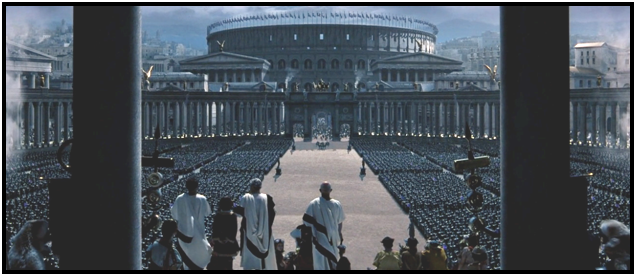 The Roman Legions Entering Rome (from the Movie “Gladiator”)
The Roman Legions Entering Rome (from the Movie “Gladiator”)
The three preceding modern armies are all modeling themselves after the Roman legions pictured above.
You may not recognize it right away. Have you ever seen the movie “Gladiator”? Okay, many have seen that movie; it was very popular. This is an early scene showing the triumphal entry of the Roman legions into Rome after it had battled to an overwhelming victory against the Germanic tribes in northern Europe. They were completely routed by the Roman legions.
Those legions then returned to Rome. They celebrated their military victory by staging a parade as they entered the city upon their return. In the front of the picture are the Senators, and in the background is the Colosseum. On the sides are the soldiers, all in battle array in a massive display of force and power and armament. In the back, on the other side of the pillars, is the crowd.
The conquering general is in the middle of the picture, standing in a chariot drawn by four horses. He is receiving tribute for their victory and will soon make his way amid thunderous cheering up to the Emperor, who is there with the Senators to receive the glory and accolades deserved for the triumph.
Modern Armies Model Roman Practice
Armies to this very day emulate this ancient practice that goes back many ages to the rise of the Roman empire.
Now I want you to think for a moment. Compare the next two pictures. The first one shows the Emperor Titus in a bas-relief carved into his sarcophagus. It’s over 2,000 years old so there’s a lot of damage, but you can see the chariot and the four horses.
The Sarcophagus of the Emperor Titus
Marcus Aurelius with an Angel on His Shoulder
The immediately preceding picture is a relief depicting Marcus Aurelius, who happened to be the Emperor portrayed in the movie “Gladiator.” Here he is seen entering the city of Rome as the conquering general and emperor, with four horses and a chariot.
The reason I wanted to show you this particular picture is that there’s an angel perched on Aurelius’ shoulder. In Roman times that angel, who is depicted as giving the general divine advice for victory, was named Genius, from which we derive the modern word.
What Was Jesus’ Message About the Donkey?
Now compare all of these Roman and military scenes to the following picture from a Sunday-school book about Palm Sunday.
Jesus Entering Jerusalem on a Donkey
The question I would like you to ponder is why Jesus entered Jerusalem riding a donkey. Everybody knew the proper way to enter a city to reap the glory of victorious battle. Why did he do it this way? There are no armaments at all. Nobody is in Rome, following their rank. There are women and children and old people and young people.
Why did Jesus enter on a donkey rather than in a chariot drawn by four warhorses? What was he trying to get across?
I would like to answer this question for you, but I really shouldn’t. It would be like telling the punch line to a joke. It’s more appropriate for you to answer the question yourself when you compare the Roman way of entering a city with Jesus’ way of entering Jerusalem. What is in your heart is what’s right for you at this time. I can give you a Biblical answer; I can give you a theological answer. But it would only be my answer. You have your own thoughts about why Jesus entered his city in his own special way.
A Renaissance Woodcut of Jesus Entering Jerusalem on a Donkey
This picture shows the same kind of thing as the one before it – the donkey, average people, a chaotic crowd. It’s not orderly, there are no armaments, no chariots, no spears, no tanks. Once again, why did Jesus do it this way? What was his message?
Now I want you to hang on to the answer you have developed about why he did this. Just put it in your short-term memory for a moment while I tell you two more stories. Then I’m going to ask you to think about three things – the answer you have formulated in your mind as to why Jesus entered Jerusalem in a special way and the following two stories. I’ll ask you to put the three together. It’s not going to be easy, but I want you to try.
Don’t Drop It, Tom; It’s Very Very Heavy
This story is much different, an extraordinarily rare photographic image. Back in January, it was published in all sorts of scientific journals. It is the very first image ever seen of another planet outside our solar system. They’re called exoplanets. We’ve got pictures of Jupiter, Mars, and others, but they’re all in our solar system, all nearby. Here is a planet orbiting a star that is nevertheless very close to us in terms of the cosmos. Our nearest star, the sun, is four light-years away. This one is 63 light-years away.
Photo of an Exoplanet Taken at a Distance of 63 Light-Years from Earth
This exoplanet’s sun is the big dot in the middle of the photo, but the blue area that’s all around it in the center, where all the brightness of the star should be, is blocked out by software. The planet is the little white dot at the bottom right. It’s about 32-60-some pixels wide, and that’s as big as it is.
By the way, here is a picture of the team of astrophysicists rejoicing at the existence of this photograph. They say this exoplanet is 63 percent larger than Jupiter and is obviously very close to its sun.
Astrophysicists up in the Air at Success of Photo Taken at Incredible Distance
Here’s a planet that should be extremely volcanic due to its proximity to that sun. The gravitational forces of a huge planet so close to a giant star would have to be incredibly strong. This planet is therefore being squeezed and pulled, and squeezed and pulled as it orbits around this sun. The two bodies are very close to each other, and both are enormous. For comparison, Jupiter is our biggest planet, and the newly pictured planet is 63 percent bigger than that. So we’re talking about a very volatile place, larger than Jupiter and 63 light-years away.
I pulled out my calculator. Taking a photograph of that planet would be like making a photograph of your face except that your face would be two-thirds of the way to the moon. It is the equivalent of taking a photograph of a grain of sand except that the grain of sand is in Los Angeles. Also, I want you to appreciate the technology and science that were necessary to take this photograph.
Now please turn around and face the rear of the sanctuary. There’s Tom, one of our deacons, standing in the back of the sanctuary. When he went out to ring the bell this morning, I asked him to bring in a single grain of sand, and he’s holding it up for you to see. You can’t see it? Okay, he’s holding the grain of sand; you can guess how big it is. “All right, Tom, it represents a huge planet. Just don’t drop it.”
Now if I were to whip out the little camera on my phone and take a picture of the single grain of sand, would you be able to see it? No, not even close, and it’s only a few yards away. So imagine the special camera, the science and technology that enabled the astrophysicists to take a picture that ended up giving us a view of a grain of sand, except the grain of sand is in Los Angeles.
That’s what this photograph is like, and it’s the first time it has happened in the history of humanity. It should be in a church, if you ask me.
Female Quail Sacrifices Self to Brood
One more story to tell you. Does anybody know what this picture shows? It’s a quail, a male quail on the right, and the female on the left. You’ll notice that the male is better looking – one of those universal things in nature. (Um-m-m. Uh-h-h. Ha!)
Female Quail at Left; Male Quail at Right
Quail Chicks
This story happened last summer. There was a heat wave out West, and in northern California there was a big forest fire. After the fire had burned through and was put out, some rangers were cleaning up debris where the fire had gone through.
Up against a tree one of the rangers spotted a quail. It was completely black. It had been burned but was still standing right up against that tree with all its feathers completely charred. The whole bird was thoroughly blackened. The ranger went over and touched the quail, but it didn’t move. It just toppled over, and out from underneath the hen waddled three little chicks.
What the mother hen had probably done was to make a terrifying choice between fleeing the fire and abandoning her covey or choosing to stay to try to protect the flightless brood. Her choice was a primal one. She opened her wings, the little ones climbed underneath, and all four stood by the tree awaiting the fire.
The fire came roaring down over them. The mother quail died. Her chicks lived.
What I want you to do now is to put these three images together. Try to imagine the kind of love the mother quail had for her little ones, and combine that thought with the kind of tenacity, the kind of technology, the kind of human force that we can put behind a project to achieve something important to us. And to succeed at accomplishing a significant undertaking such as a photograph of a planet 63 light-years away.
Then I want you to meld those two ideas and join them with the concept of humility, of nonviolence, of a desire to change the value system of a violent society. To upend the way in which people routinely do business, to know that the prince of peace rides in on a donkey, not being drawn in a chariot by four stallions.
If we would take that message and combine it with unconditional love and the fortitude of which human beings are capable, that, my friends, is what Palm Sunday is about.
Amen.

